Open access paper Ancient genomes reveal social and genetic structure of Late Neolithic Switzerland by Furtwängler et al. Nat. Commun. (2020).
Interesting excerpts (emphasis mine):
The ancient individuals from this study originate from 13 Neolithic and Early Bronze Age sites in Switzerland, Southern Germany, and the Alsace region in France. All samples taken from the individuals were radiocarbon dated.

The arrival of Steppe ancestry
Two distinct clusters can be identified and were also confirmed by ADMIXTURE analysis, one consisting of individuals dating to 4770–2500 calBCE, and one comprising individuals dating to 2900–1750 calBCE. The oldest individuals from the sites of Niederried (CH) and Lingolsheim (F) fall close to ancient individuals from Anatolia associated with early agricultural contexts. More recent individuals from the megalithic burials at Oberbipp (CH) and Aesch (CH) are shifted further towards Western Hunter-Gatherers (WHG) and close to modern-day Sardinian individuals, as well as towards Early and Middle Neolithic individuals from Iberia or the Middle Elbe-Saale (MES) region in Central Germany
The second distinct cluster is shifted towards the individuals associated with the “Yamnaya” complex, similar to other European groups younger than 2700 BCE, relative to individuals older than 2700 BCE. In this cluster, the oldest individuals are closest to Late Neolithic groups on the steppe, whereas more recent individuals are once again shifted towards the Middle/Late Neolithic cluster. All Final Neolithic and Early Bronze Age individuals fall within the range of modern-day Europeans, but none of the newly sequenced individuals of this study overlap with the present-day Swiss populations in this analysis, suggesting additional population changes in the region after the Middle Bronze Age.
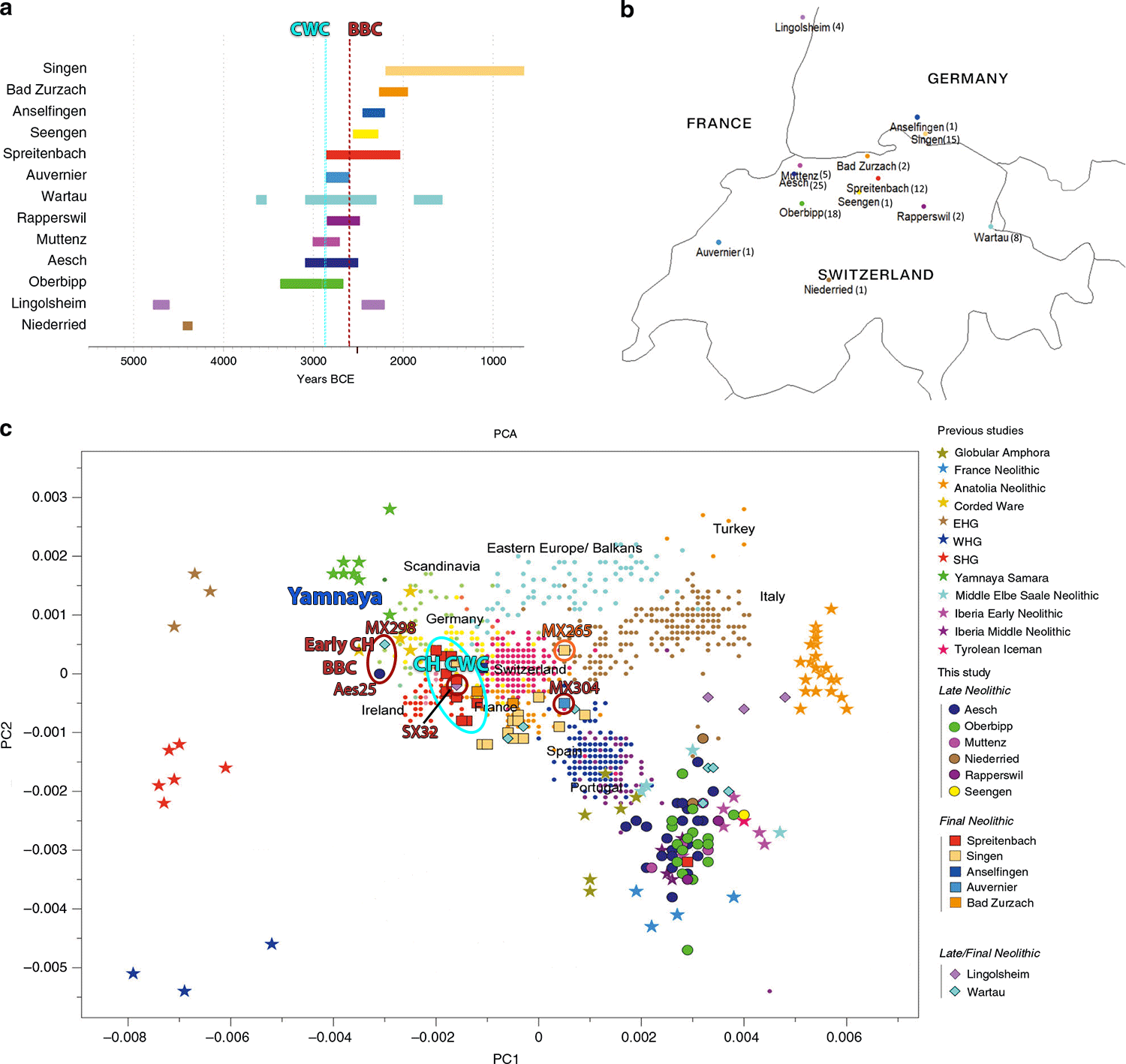
Date of arrival of Steppe ancestry
By viewing the YAM-related ancestry component estimated with qpAdm over time at an individual level, it becomes apparent that this ancestry was virtually absent before 2700 BCE, followed by a steep increase in parts of the population starting around 2700 BCE. After this rapid increase in individual proportions of YAM-related ancestry from 0% to ~60%, a decrease down to 25–35% can be observed over the next thousand years. We also note four female individuals that can be modeled without any YAM-related ancestry even 1000 years after the appearance of that genetic component in the area.

Male bias of Steppe ancestry
Comparing outgroup-f3 statistics between the autosomes and the X chromosome of Final Neolithic and Bronze Age individuals we find that autosomes are more closely related to YAM-related ancestry than the X chromosomes are, consistent with a model in which more males than females brought YAM-related ancestry into the region as already shown by previous studies.
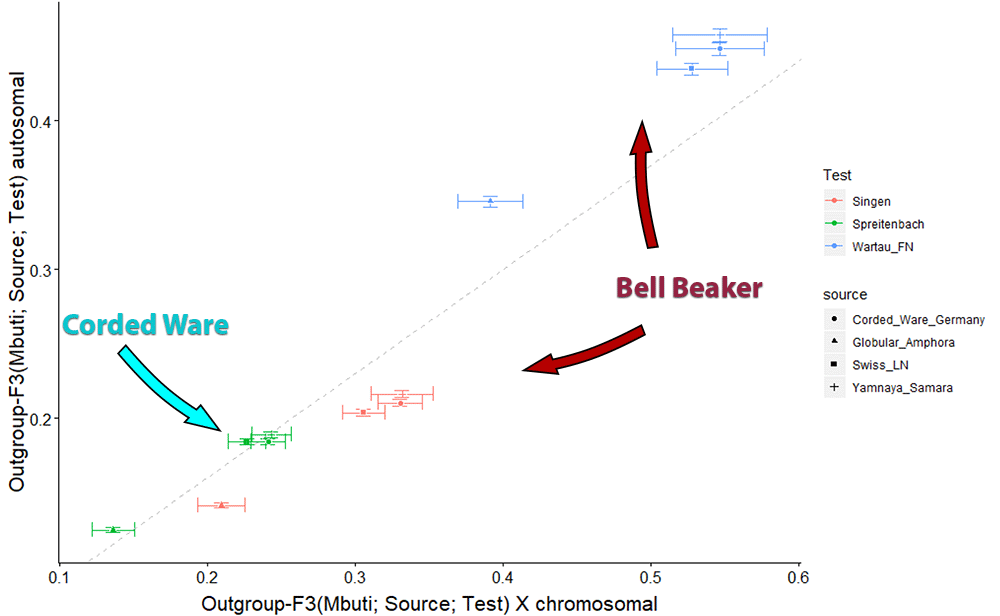
Patrilocal societies with female exogamy
In five burial sites, we identified first-degree relatives using the software lcmlkin23 and READ24, and by calculating pairwise mismatch rates across all analyzed genomic sites between individuals. Four of these sites contained more than two closely related individuals, which allowed us to reconstruct family trees spanning three generations for Oberbipp, Aesch and Singen. In these multiple burials, only a few female individuals (four individuals) were buried together with one of their parents or their sons, compared with a higher number (21 individuals) of males buried with their father, brothers or sons, indicating that males likely tended to stay where they were born, while females were likely mobile.
The social and family structures, as reconstructed by biological kinship networks, remain the same before and after the arrival of steppe-related ancestry in the region. The predominant social structure in populations buried at the sites investigated in this study must have been a patrilocal society where males stayed where they were born, and females came from more distant living families, a societal dynamic which has been confirmed by stable isotopes and that has been previously documented for the Middle Neolithic. Also, higher female mobility has been shown during the Early Bronze Age. Our study also presents one of the earliest evidence for adult lactose tolerance in Europe, dating to 2105–2036 calBCE.
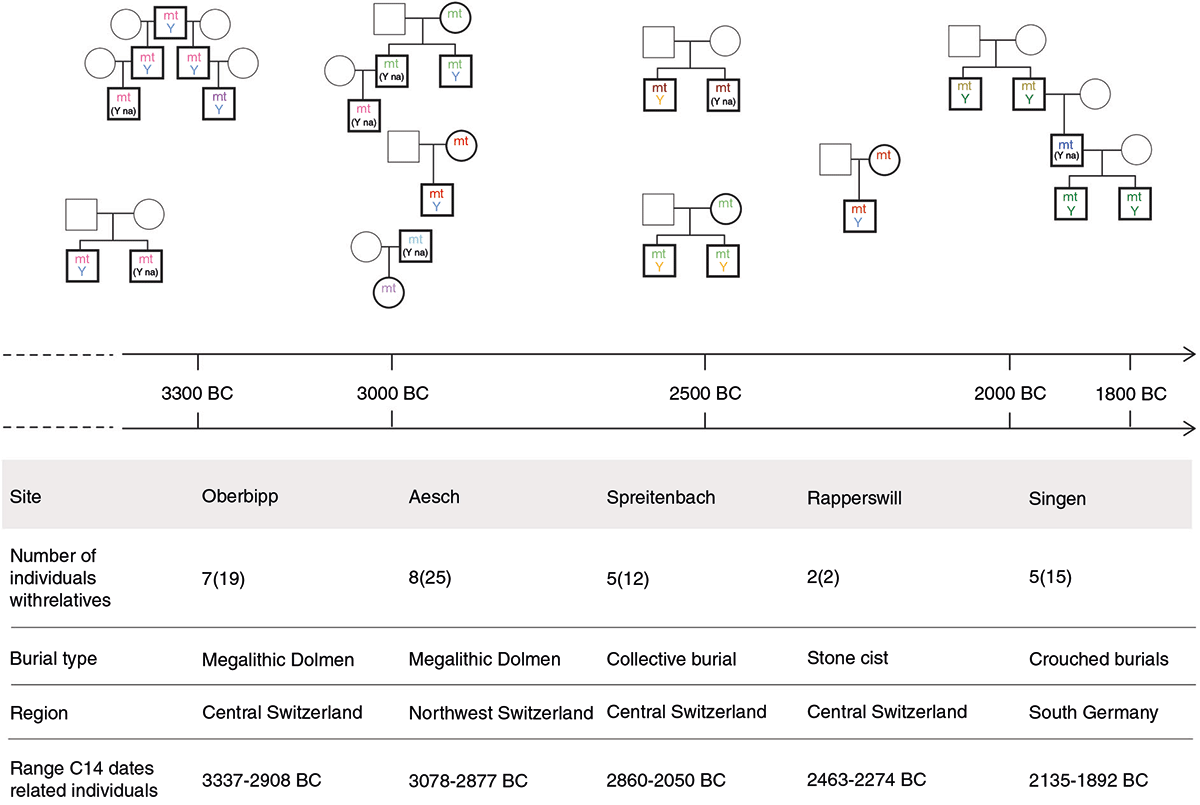
Uniparental markers
In individuals older than 2600 BC originating from the sites of Oberbipp, Aesch and Muttenz only haplogroups belonging to the clades I2a and G2a were found. Besides the youngest Aesch individual Aesch25, which carries a R1b haplogroup.
In the younger site of Spreitenbach associated with the Corded Ware complex only haplogroups of the clades I2c and I2a are present. In the contemporaneous sample from Lingolsheim R1b could be determined.
All samples in the dataset younger than 2200 BC all individuals carry R1b, beside MX265 from Singen, which belongs to R1a.

Comments
I. Corded Ware culture demise
This paper confirms yet again the finds of Linderholm et al. (2020), Malström et al. (2019), and Fernandes et al. (2018), where Corded Ware groups show varied lineages and increased local admixture over time everywhere in Europe far from the Steppe, most of them representing cultural dead ends after the arrival of R1b-rich Bell Beakers.
In terms of Y-DNA lineages, this Corded Ware group from Spreitenbach shows hg. I2a1a2(a)-CTS5375(L161), with a likely western Neolithic origin according to available ancient DNA. This contrasts with the (also probably resurged) I2a1b1a2b1-L801 lineages found in late Polish Corded Ware – with the same haplogroup found among Globular Amphorae groups – and with the I2a1a1b1b-M838 found among Czech Corded Ware individuals – proper of central European Neolithic groups.
Similarly, the ancestry proper of early Corded Ware peoples, starting ca. 2700 BC or earlier in Switzerland, shows an increased regional component reminiscent of the already known cases of the Single Grave culture in Denmark (ca. 2670 BC), late Battle Axe culture in Sweden (ca. 2600 BC on), and young Corded Ware samples from Germany and Bohemia, all of them originally part of R1a-rich communities.
This increasing variability in male lineages displayed by all late Corded Ware communities (compared e.g. to the homogeneous Yamnaya and Bell Beakers) suggests that part of them might have developed through imitation of the Corded Ware package during admixture events at a time when cultural cohesion had already become weaker; or, alternatively, that there was some social mechanism within the Corded Ware culture which made the incorporation of neighbouring local males from different cultures possible. Strong evidence for cultural diffusion of Corded Ware exists already, especially for the Single Grave culture, as described in Kroon et al. (2019).
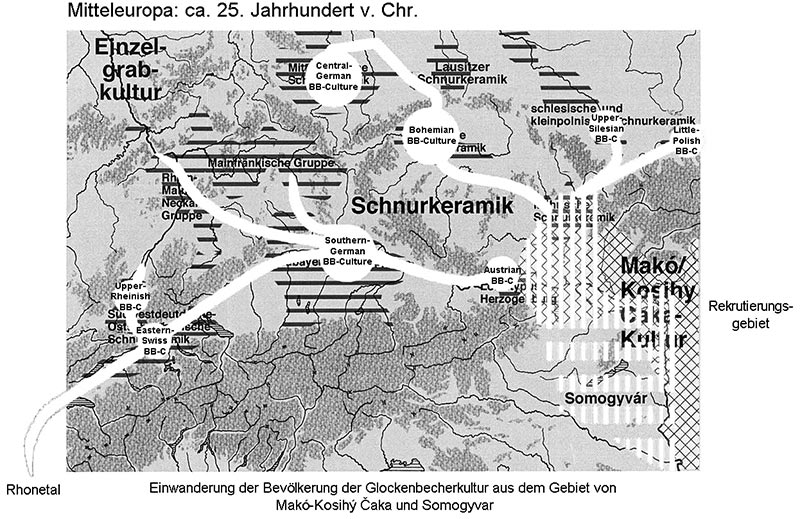
II. Early Bell Beakers
This variability of “Steppe ancestry” and local admixture with haplogroup infiltration among late (A-horizon) Corded Ware groups contrasts heavily with the tight family ties and increase in Yamnaya ancestry that – once again – is found among early R1b-rich Bell Beakers, represented in this study by samples that appeared during the transition of the Final Neolithic to the Early Bronze Age among megalithic-building cultures.
1) The potentially earliest Bell Beaker R1b-L151 sample is MX304, from Auvernier (ca. 2866-2601), but its date is taken from another individual of the same burial, and its ancestry shows more regional admixture, so it seems likely that the burial was reused later.
2) The earliest radiocarbon date in an R1b-M269 sample, if we include the whole confidence interval, comes from sample MX310 at Burgäschisee (ca. 2862-2581 cal-2σ BC), a site which shows Final Neolithic flint production of arrowheads similar to those made among East Bell Beakers (Horváth 2012).
3) Another early date comes from the youngest sample of the Aesch dolmen, the Steppe-rich Aes25 (ca. 2864-2501 cal-2σ BC), which is interpreted (like some dolmens of the cemetery at Petit-Chasseur) as of the Bell Beaker culture, “by re-occupation of the funerary chamber of the Final Neolithic” (Desideri & Bessi 2010). The finding of a G2a-rich community using the dolmen as family burial ca. 2930-2676 calBC puts a terminus post quem in the lower range (repeated in many samples).
4) The most likely interval for Aes25 (and thus probably MX310) is given by the nearby population from Wartau, especially the male MX298 (ca. 2620-2448 cal-2σ BC, mean ca. 2534 BC), who forms part of the same cluster in the PCA. The site was located to the south-east of Aesch, and is scarcely known, mainly for its dolmens and flint daggers made from southern Alpine/Upper Italian ‘Monte-Lessini’ flint and related rock types, exported to the north as finished products, tying it thus to (Proto-)Bell Beaker materials (Schindler 2001 as referenced in Heyd 2007).
Without information about the specific subclade or cultural context, it is unclear if MX298, of hg. G2a-PF3147, might be related to westward waves of the subclade – found among South-Central European and Balkan Neolithic populations, including Baden Chalcolithic samples in immediate contact with the Yamnaya – or rather to an admixture among locals, who also show this lineage.
The prevalent practice of exogamy would suggest that high-Steppe females that appeared during the mid-3rd millennium could have come from high-Steppe Bell Beaker communities with close family and cultural ties with the early Bell Beaker groups from Switzerland, but they could also have come from neighbouring Corded Ware populations, just like the fully EEF-like females sampled until the late 3rd millennium BC must have come from Final Neolithic / EBA (Proto-Beaker?) populations not far away.
Origin of increased Steppe ancestry
The only populations that – around 2700 BC – could show up to 100% Steppe ancestry were in the Carpathian Basin and in the Pontic-Caspian area, with all Corded Ware groups from Central Europe showing considerably less. In fact, some of the most Steppe-shifted Corded Ware individuals received most likely a recent admixture through exogamy with Yamnaya vanguard groups, like the late CWC family from Esperstedt.
The finding of L151* and L151 subclades among early Bell Beakers with “Steppe ancestry” intermediate between Yamnaya and Corded Ware – as previously reported for an early Rhine Beaker of hg. R1b-L151 – together with their male-biased migration suggests that (barring some impossible genetic drift) a nearby population packed with Yamnaya ancestry spread to the Upper Rhine basin as early as the 26th century BC, and kept migrating downriver, admixing with Corded Ware-derived populations through exogamy.
Here is a reminder of what a PCA will look like with (yet unpublished) Yamnaya Hungary samples, representative of several ten thousands fully Yamnaya-like individuals of the Danube-Tisza interfluve that expanded (ca. 3100-2700 BC) in constant westward migration waves up the Danube River basin:
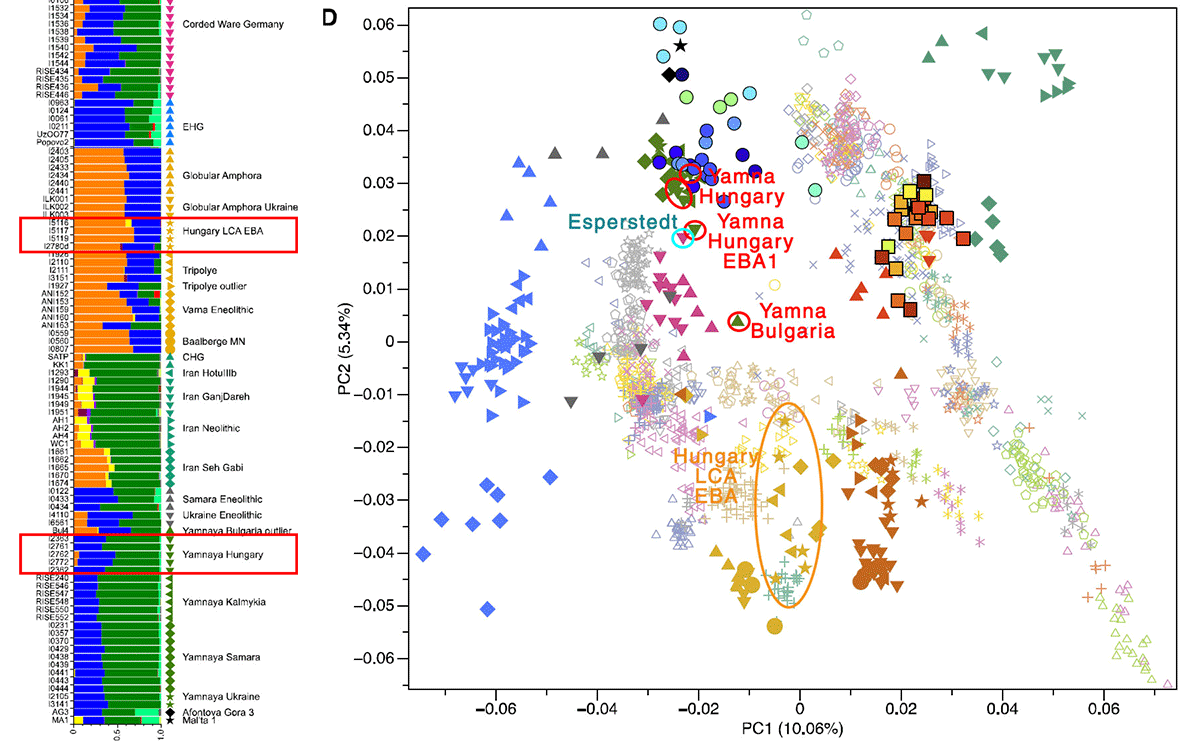
As for the increase in WHG-related ancestry among both early Bell Beaker samples, which shifts them ‘to the north’ in terms of modern populations, it can be easily explained by the admixture with local, WHG-rich Neolithic groups. A similar admixture is also found among Bell Beaker and BA samples from Hungary in Olalde et al. (2018), and among Danubian EBA samples in Mittnik et al. (2019).
The increase in Steppe- and WHG-related ancestry with their Modern Northern-like cluster shows that a southern early Bell Beaker Yamnaya-related population rich in hg. R1b-L151 made its way to the north through the river basins of the Rhine (in the case of Lower Rhine and British Bell Beakers), the Wesser, and the Elbe (in the case of Mittelelbe-Saale Beakers), admixing with other peoples of Steppe- and/or EEF-related ancestry – either decreasing or increasing its “Steppe component” along the way, depending on the specific groups they admixed with. All ‘northern’ Bell Beaker and Beaker-derived populations can be thus explained as an expansion of Bell Beakers from the Upper Danube.
While the dates are surely in the lower range of those wide reported intervals, the potential finding of R1b-rich Bell Beakers of high Steppe ancestry already during the 26th c. BC in Switzerland sets an interesting terminus ante quem also for Bell Beakers in Central Europe, and suggests that the traditional date of ca. 2500 BC for Bell Beakers expanding through the Upper Danube system (as mentioned e.g. in Anthony 2007) might need to be shifted one century back now with proper radiocarbon dating, to justify such an explosive expansion.
That is in line with the expected finding of Yamnaya vanguard settlers all over Central Europe roughly ca. 2700 BC or earlier, and of Yamnaya-related cultural influence among Final Neolithic populations reaching up to Southern Iberia. Such earlier dates for Central European interaction correlate particularly well with the finding of early Proto-Beakers without Steppe ancestry appearing also earlier than expected in NE Iberia and France, already during the 27th c. BC, as reported in Olalde et al. (2018).
NOTE. Nevertheless, it is not rare to find occasionally very wide confidence intervals – including even 2800+ (cal)BC – among isolated Steppe-related Bell Beaker R1b-P312 samples, such as those available from the British Isles or from Sicily, which can be easily considered outside of the likely Bell Beaker range. The reviewers caution against taking these early dates (for all Steppe-related Swiss samples) at face value, given the potential reservoir effect in lacustrine systems, especially without information on the diet of these individuals. The authors themselves appear to select for their Y-DNA graphic the R1b-L51 sample from Lingolsheim (ca. 2463-2208 cal-2σ BC) as the earliest representative of R1b in the whole studied area, which might be related to the reviewer’s concern about those dates.
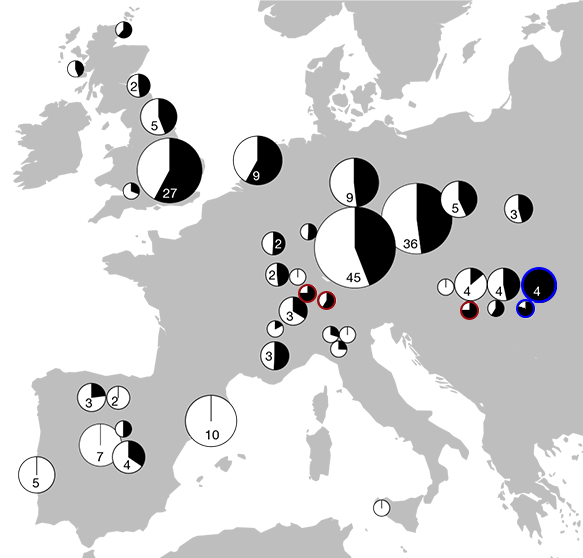
NOTE. Estimates of “Yamnaya Samara” ancestry with qpAdm published in the supplementary materials seem unreliable, contradicting previous values confirmed in other papers, but the position of the samples in the PCA suggest that they are similar to the published high-Steppe Esperstedt and BBC Hungary.
III. R1a-M458 among Celtic-speaking peoples
Sample MX265 from Singen, Germany (ca. 763-431 cal-2σ BC) probably belonged to La Tène or its immediate predecessor in this Western Alpine region, which links it directly to the most likely Common Celtic homeland. While I associated three years ago the recent bottleneck of R1a-M458 with the spread of Balto-Slavic (eastwards with the Lusatian culture) and Slavic (westwards with the Prague-Korchak culture), last year I questioned this association based on the fact that 100% of recovered R1a-M458 individuals (from the Early and Late Middle Ages) can be directly associated with Germanic peoples – even those sampled from Slavic-speaking areas. The finding of this lineage among early Celts supports even more that it became incorporated early into East Bell Beakers.
The question now remains: did independent R1a-M458 lineages expand with different Indo-European-speaking cultures, or did different succeeding infiltrations and bottlenecks (Celtic → Germanic → Slavic) obfuscate the true origin of the lineage? After all, the ancestry of MX265, in line with Northern Italians and South Slavic peoples judging by its PCA cluster (corroborating the expected Italo-Celtic cluster), suggests that this lineage might have spread eastwards and northwards with Celts during the Early Iron Age, and that it was only later incorporated into Germanic- and Slavic-speaking peoples.
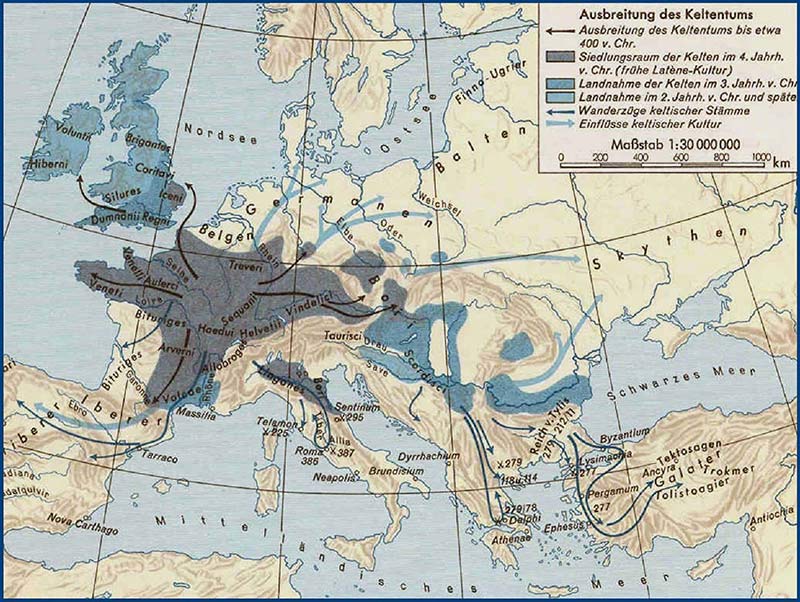
On the other hand, this simplistic vision doesn’t account for distinct subclades potentially associated with different cultures, especially given the early formation date of R1a-M458 compared to its late TMRCA (see YFull estimates). It is still possible that the expansion of the ancestors of most modern descendants happened around the Baltic during the Bronze Age, which would connect both Germanic and Balto-Slavic individuals to Early Iron Age expansions, fully unrelated to this Celtic sample. Maybe the findings from the Tollense valley will give insight into the ancestral history of its subclades.
A similar case can be found in R1b-DF27 subclades which peak today within Iberia, like R1b-M167, which was absent from the whole Iberia Bronze Age transect published, and was thus likely associated with Celtic expansions, being much later found among sampled Vikings from Britain. Their modern peak in Eastern Iberia reflects Middle Age bottlenecks, probably associated to the southward expansion of the Kingdom of Aragon (visible in admixture, too), rather than some ancestral connection with Iberian-speaking peoples, as it was supposed in the 2000s based on maps of modern distributions.
It is important to repeat that, even if R1a-M458 did expand with Proto-Slavic-speaking peoples (and was not already in the region when they arrived , which looks now more likely than ever), its origin, much like that of “Dinaric” I2a-L621 – which has been found to date already associated with all early Slavic groups – comes probably from the west with Bell Beaker-associated cultures, rather than from any eastern Corded Ware-derived one. That offers yet another clear ancestral genetic link between all ancient North-West Indo-European-speaking peoples.
See also
- The Corded Ware culture, more complex than previously thought
- Yamnaya ancestry: mapping the Proto-Indo-European expansions
- Corded Ware ancestry in North Eurasia and the Uralic expansion
- “Steppe ancestry” step by step (2019): Mesolithic to Early Bronze Age Eurasia
- Bell Beakers and Mycenaeans from Yamnaya; Corded Ware from the forest steppe
- East Bell Beakers, an in situ admixture of Yamna settlers and GAC-like groups in Hungary
- Yamnaya replaced Europeans, but admixed heavily as they spread to Asia